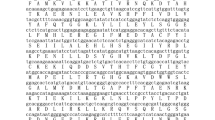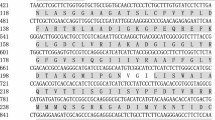Abstract
The transforming growth factor-β (TGF-β) signaling pathway is conserved across animals, and knowledge of its roles during the molt cycle in crustaceans is presently very limited. This study investigates the roles of the TGF-β receptor in molting-related muscle growth in Eriocheir sinensis. Using the RT-PCR and RACE techniques, we obtained a 1722 bp cDNA sequence encoding a transforming growth factor-β type I receptor in Eriocheir sinensis, designated EsTGFBRI, which contains a 124 bp 5′-untranslated region, a 20 bp partial 3′-untranslated region and a 1578 bp open reading frame encoding 525 amino acids. The deduced EsTGFBRI contains an N-terminal 24 amino acid signal peptide, an activin type I and II receptor domain, a transmembrane helix region, a glycine-serine-rich motif, and a conserved serine/threonine kinase catalytic domain including an activation loop. The qRT-PCR results showed that EsTGFBRI gene was highly expressed in the intermolt testis and ovary in mature crabs. In juvenile crabs, the mRNA levels of EsTGFBRI in claw and abdominal muscles in the later premolt D3–4 stage were significantly higher than those in the intermolt C and postmolt A–B stages. There was no significant change in EsTGFBRI mRNA levels in walking leg muscles during the molt cycle. The results suggest that EsTGFBRI is probably play roles in molting-related muscle growth in E. sinensis. This study provides a necessary basis for elucidating the functions of TGF-β-like signaling mediated by TGFBRI in molting-related muscle growth in crustaceans.







Similar content being viewed by others
References
Heldin C-H, Landström M, Moustakas A (2009) Mechanism of TGF-β signaling to growth arrest, apoptosis, and epithelial-mesenchymal transition. Curr Opin Cell Biol 21(2):166–176
Nickel J, Pt Dijke, Mueller TD (2018) TGF-β family co-receptor function and signaling. Acta Biochim Biophys Sin 50(1):12–36. https://doi.org/10.1093/abbs/gmx126
Lee S-J, Reed LA, Davies MV, Girgenrath S, Goad MEP (2005) Regulation of muscle growth by multiple ligands signaling through activin type II receptors. Pans 102:18117–18122. https://doi.org/10.1073/pnas.0505996102
Budi EH, Xu J, Derynck R (2016) Regulation of TGF-beta receptors. Methods Mol Biol 1344:1–33. https://doi.org/10.1007/978-1-4939-2966-5_1
Vander Ark A, Cao J, Li X (2018) TGF-beta receptors: in and beyond TGF-beta signaling. Cell Signal 52:112–120. https://doi.org/10.1016/j.cellsig.2018.09.002
Kwak EA, Lee NY (2019) Synergetic roles of TGF-beta signaling in tissue engineering. Cytokine 115:60–63. https://doi.org/10.1016/j.cyto.2018.12.010
Zi Z (2019) Molecular engineering of the TGF-beta signaling pathway. J Mol Biol 431(15):2644–2654. https://doi.org/10.1016/j.jmb.2019.05.022
Itoh S, Pt Dijke (2007) Negative regulation of TGF-β receptor/Smad signal transduction. Curr Opin Cell Biol 19(2):176–184. https://doi.org/10.1016/j.ceb.2007.02.015
Yeo C-Y, Whitman M (2001) Nodal signals to Smads through criptodependent and cripto-independent mechanisms. Mol Cell 7(5):949–957. https://doi.org/10.1016/S1097-2765(01)00249-0
Reissmann E, Jornvall H, Blokzijl A, Andersson O, Chang C, Minchiotti G, Persico MG, Ibanez CF, Brivanlou AH (2001) The orphan receptor ALK7 and the activin receptor ALK4 mediate signaling by Nodal proteins during vertebrate development. Genes Dev 15(15):2010–2022. https://doi.org/10.1101/gad.201801
Rebbapragada A, Benchabane H, Wrana JL, Celeste AJ, Attisano L (2003) Myostatin signals through a transforming growth factor beta-like signaling pathway to block adipogenesis. Mol Cell Biol 23(20):7230–7242
Nakerakanti S, Trojanowska M (2012) The role of TGF-beta receptors in fibrosis. Open Rheumatol J 6:156–162. https://doi.org/10.2174/1874312901206010156
Das S, Pitts NL, Mudron MR, Durica DS, Mykles DL (2016) Transcriptome analysis of the molting gland (Y-organ) from the blackback land crab, Gecarcinus lateralis. Comp Biochem Physiol Part D 17:26–40. https://doi.org/10.1016/j.cbd.2015.11.003
Abuhagr AM, MacLea KS, Mudron MR, Chang SA, Chang ES, Mykles DL (2016) Roles of mechanistic target of rapamycin and transforming growth factor-beta signaling in the molting gland (Y-organ) of the blackback land crab, Gecarcinus lateralis. Comp Biochem Physiol A 198:15–21. https://doi.org/10.1016/j.cbpa.2016.03.018
Shyamal S, Das S, Guruacharya A, Mykles DL, Durica DS (2018) Transcriptomic analysis of crustacean molting gland (Y-organ) regulation via the mTOR signaling pathway. Sci Rep 8(1):7307. https://doi.org/10.1038/s41598-018-25368-x
Das S, Vraspir L, Zhou W, Durica DS, Mykles DL (2018) Transcriptomic analysis of differentially expressed genes in the molting gland (Y-organ) of the blackback land crab, Gecarcinus lateralis, during molt-cycle stage transitions. Comp Biochem Physiol Part D 28:37–53. https://doi.org/10.1016/j.cbd.2018.06.001
Jaramillo ML, Guzman F, Paese CL, Margis R, Nazari EM, Ammar D, Muller YM (2016) Exploring developmental gene toolkit and associated pathways in a potential new model crustacean using transcriptomic analysis. Dev Genes Evol 226(5):325–337. https://doi.org/10.1007/s00427-016-0551-6
Lv J, Liu P, Gao B, Wang Y, Wang Z, Chen P, Li J (2014) Transcriptome analysis of the Portunus trituberculatus: de novo assembly, growth-related gene identification and marker discovery. PLoS ONE 9(4):e94055. https://doi.org/10.1371/journal.pone.0094055
Jiang Q, Min Y, Yang H, Wan W, Zhang X (2019) De novo transcriptome analysis of eyestalk reveals ovarian maturation related genes in Macrobrachium rosenbergii. Aquaculture 505:280–288. https://doi.org/10.1016/j.aquaculture.2019.02.07
Nguyen C, Nguyen TG, Nguyen LV, Pham HQ, Nguyen TH, Pham HTH, Nguyen T, Ha TT, Dau TH (2016) De novo assembly and transcriptome characterization of major growth-related genes in various tissues of Penaeus monodon. Aquaculture 464:545–553
Covi JA, Bader BD, Chang ES, Mykles DL (2010) Molt cycle regulation of protein synthesis in skeletal muscle of the blackback land crab, Gecarcinus lateralis, and the differential expression of a myostatin-like factor during atrophy induced by molting or unweighting. J Exp Biol 213(1):172–183. https://doi.org/10.1242/jeb.034389
Covi JA, Kim HW, Mykles DL (2008) Expression of alternatively spliced transcripts for a myostatin-like protein in the blackback land crab, Gecarcinus lateralis. Comp Biochem Physiol A 150(4):423–430. https://doi.org/10.1016/j.cbpa.2008.04.608
MacLea KS, Abuhagr AM, Pitts NL, Covi JA, Bader BD, Chang ES, Mykles DL (2012) Rheb, an activator of target of rapamycin, in the blackback land crab, Gecarcinus lateralis: cloning and effects of molting and unweighting on expression in skeletal muscle. J Exp Biol 215(Pt 4):590–604. https://doi.org/10.1242/jeb.062869
MacLea KS, Covi JA, Kim HW, Chao E, Medler S, Chang ES, Mykles DL (2010) Myostatin from the American lobster, Homarus americanus: cloning and effects of molting on expression in skeletal muscles. Comp Biochem Physiol A 157(4):328–337. https://doi.org/10.1016/j.cbpa.2010.07.024
Sp E, Bhassu S (2016) Myostatin: a potential growth-regulating gene in giant River Prawn, Macrobrachium rosenbergii. J Word Aquac Soc 46(6):624–634. https://doi.org/10.1111/jwas.12238
Zhuo RQ, Zhou TT, Yang SP, Chan SF (2017) Characterization of a molt-related myostatin gene (FmMstn) from the banana shrimp Fenneropenaeus merguiensis. Gen Comp Endocrinol 248:55–68
De Santis C, Wade NM, Jerry DR, Preston NP, Glencross BD, Sellars MJ (2011) Growing backwards: an inverted role for the shrimp ortholog of vertebrate myostatin and GDF11. J Exp Biol 214(Pt 16):2671–2677. https://doi.org/10.1242/jeb.056374
Lee JH, Momani J, Kim YM, Kang CK, Choi JH, Baek HJ, Kim HW (2015) Effective RNA-silencing strategy of Lv-MSTN/GDF11 gene and its effects on the growth in shrimp, Litopenaeus vannamei. Comp Biochem Physiol B 179:9–16. https://doi.org/10.1016/j.cbpb.2014.09.005
Shinji J, Miyanishi H, Gotoh H, Kaneko T (2016) Appendage regeneration after autotomy is mediated by baboon in the crayfish Procambarus Fallax F. Virginalis Martin, Dorn, Kawai, Heiden and Scholtz, 2010 (Decapoda: Astacoidea: Cambaridae). J Crustacean Biol 36(5):649–657. https://doi.org/10.1163/1937240X-00002458
Zhou L-L, Wang C, Gu W-B, Zhu Q-h, Wang L-Z, Zhou Z-K, Liu Z-P, Chenl Y-Y, Shu M-A (2018) Identification and functional analysis of transforming growth factor-β type I receptor (TβR1) from Scylla paramamosain: the first evidence of TβR1 involved in development and innate immunity in crustaceans. Dev Comp Immunol 88:144–151
Tian Z, Kang X, Mu S (2012) The molt stages and the hepatopancreas contents of lipids, glycogen and selected inorganic elements during the molt cycle of the Chinese mitten crab Eriocheir sinensis. Fish Sci 78(1):67–74. https://doi.org/10.1007/s12562-011-0426-8
Marchler-Bauer A, Bo Y, Han L, He J, Lanczycki CJ, Lu S, Chitsaz F, Derbyshire MK, Geer RC, Gonzales NR, Gwadz M, Hurwitz DI, Lu F, Marchler GH, Song JS, Thanki N, Wang Z, Yamashita RA, Zhang D, Zheng C, Geer LY, Bryant SH (2017) CDD/SPARCLE: functional classification of proteins via subfamily domain architectures. Nucleic Acids Res 45(D1):D200–D203. https://doi.org/10.1093/nar/gkw1129
Mura C, McCrimmon CM, Vertrees J, Sawaya MR (2010) An introduction to biomolecular graphics. PLoS Comput Biol 6(8):e1000918. https://doi.org/10.1371/journal.pcbi.1000918
Kumar S, Stecher G, Li M, Knyaz C, Tamura K (2018) MEGA X: molecular evolutionary genetics analysis across computing platforms. Mol Biol Evol 35(6):1547–1549. https://doi.org/10.1093/molbev/msy096
Huse M, Muir TW, Xu L, Chen YG, Kuriyan J, Massague J (2001) The TGF beta receptor activation process: an inhibitor- to substrate-binding switch. Mol Cell 8(3):671–682
Wrana JL, Attisano L, Wieser R, Ventura F, Massague J (1994) Mechanism of activation of the TGF-beta receptor. Nature 370(6488):341–347. https://doi.org/10.1038/370341a0
Massague J (1998) TGF-beta signal transduction. Annu Rev Biochem 67:753–791. https://doi.org/10.1146/annurev.biochem.67.1.753
Johnson LN, Noble ME, Owen DJ (1996) Active and inactive protein kinases: structural basis for regulation. Cell 85(2):149–158
Huse M, Chen YG, Massague J, Kuriyan J (1999) Crystal structure of the cytoplasmic domain of the type I TGF beta receptor in complex with FKBP12. Cell 96(3):425–436
Fan Y-S, Hu Y-J, Yang W-X (2012) TGF-β superfamily: how does it regulate testis development. Mol Biol Rep 39(4):4727–4741
Cohen S, Nathan JA, Goldberg AL (2015) Muscle wasting in disease: molecular mechanisms and promising therapies. Nat Rev Drug Discov 14(1):58–74. https://doi.org/10.1038/nrd4467
Emil R, Kristian V (2016) Mechanosensitive molecular networks involved in transducing resistance exercise-signals into muscle protein accretion. Front Physiol 7:1–9. https://doi.org/10.3389/fphys.2016.00547
Dou T, Li Z, Wang K, Liu L, Rong H, Xu Z, Huang Y, Gu D, Chen X, Hu W, Zhang J (2018) Regulation of myostatin expression is associated with growth and muscle development in commercial broiler and DMC muscle. Mol Biol Rep 45:511–522. https://doi.org/10.1007/s11033-018-4187-7
Kostyunina DS, Ivanova AD, Smirnova OV (2018) Myostatin: 20 years later. Hum Physiol 44(1):88–101. https://doi.org/10.1134/S0362119718010127
Hoogaars WMH, Jaspers RT (2018) Past, present, and future perspective of targeting myostatin and related signaling pathways to counteract muscle atrophy. Adv Exp Med Biol 1088:153–206. https://doi.org/10.1007/978-981-13-1435-3_8
Shen W, Ren G, Zhu Y, Zhang X (2015) Characterization of MSTN/GDF11 gene from shrimp Macrobrachium nipponense and its expression profiles during molt cycle and after eyestalk ablation. Genes Genom 37:441–449. https://doi.org/10.1007/s13258-015-0273-6
Tian Z, Jiao C (2019) Molt-dependent transcriptome analysis of claw muscles in Chinese mitten crab Eriocheir sinensis. Genes Genomics 41(5):515–528. https://doi.org/10.1007/s13258-019-00787-w
Mykles DL, Medler S (2015) Skeletal muscle differentiation, growth, and plasticity. In: Chang ES, Thiel M (eds) Natural history of Crustacea, vol Physiology. Oxford University Press, Oxford, pp 134–167
Acknowledgement
This work was funded by the National Natural Science Foundation of China (31572635), the Key Supporting Subject of Ecology of Shaoguan University (230079030101) and the Key Scientific Research Project of Shaoguan University (SZ2018KJ04). We would like to thank Prof. Yongxu Cheng for his kind help with animal sampling, and we would like to thank the anonymous reviewers.
Author information
Authors and Affiliations
Corresponding author
Ethics declarations
Conflict of interest
The authors declare that they have no conflict of interest.
Additional information
Publisher's Note
Springer Nature remains neutral with regard to jurisdictional claims in published maps and institutional affiliations.
Rights and permissions
About this article
Cite this article
Tian, Z., Peng, H., Deng, W. et al. Identification of a transforming growth factor-β type I receptor transcript in Eriocheir sinensis and its molting-related expression in muscle tissues. Mol Biol Rep 47, 77–86 (2020). https://doi.org/10.1007/s11033-019-05108-8
Received:
Accepted:
Published:
Issue Date:
DOI: https://doi.org/10.1007/s11033-019-05108-8




